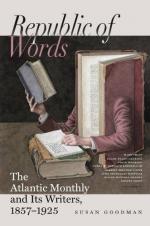Mr. Church has the eagle eye to measure this vastness. He loves a wide expanse, a boundless horizon. He does not, gypsy-like, hide with Gainsborough beneath a hedge, but his glance sweeps across a continent, and no detail escapes him. This is what makes the “Andes” a really marvellous picture. In intellectual grasp, clear and vivid apprehension of what he wants and where to put it, we think Mr. Church without an equal. Quite a characteristic of his is a love of detail and finish without injury to breadth and general effect. You look into his picture with an opera-glass as you would into the next field from an open window. His power is not so much one of suggestion, an appeal to the beauty and grandeur in yourself, as the ability to become a colorless medium to beauty and grandeur from without; hence the impression is at first hand, and such as Nature herself produces.
The world abounds in pictures where loving human faculty has lifted ordinary motives into our sympathy; but where the subject is the grandest landscape affluence of the world, effect, in the ordinary sense, ceases to be of value. We need the thing, and no human ennobling of it. In this picture we have it; no spectral cloud-pile, but a real Chimborazo, with the hoar of eternity upon its scalp, looks down upon the happy New-Yorker in his first May perspiration. And as the wind sets east, no yellow hint at something warming, but whole dales and plains still in the real sunshine, take the chill from off his heart. No wonder he, his wife, and his quietly enthusiastic girls throng and sit there. They are proud in their hearts of the handsome young painter. And well they may be! Never has the New World sent so native a flavor to the Old. Unlike so many others of our good artists, there is no saturation from the past in Mr. Church. No souvenir of what once was warm and new in the heart of Claude or Poussin ages the fresh work. It has a relish of our soil; its almost Yankee knowingness, its placid, clear, intellectual power, with its delicate sentiment and strong self-reliance, are ours; we delightfully feel that it belongs to us, and that we are of it.
Such is the last great work of the New York school of landscape,—a living school, and destined to long triumphs,—already appreciated and nobly encouraged. Its members are men as individual and various in their gifts, as they are harmonious and manly in their mutual recognition and fellowship.
* * * * *
REVIEWS AND LITERARY NOTICES.
Love Me Little, Love Me Long. By CHARLES READE, Author of “It is Never too Late to Mend,” “White Lies,” etc. New York: Harper & Brothers. 1859.




